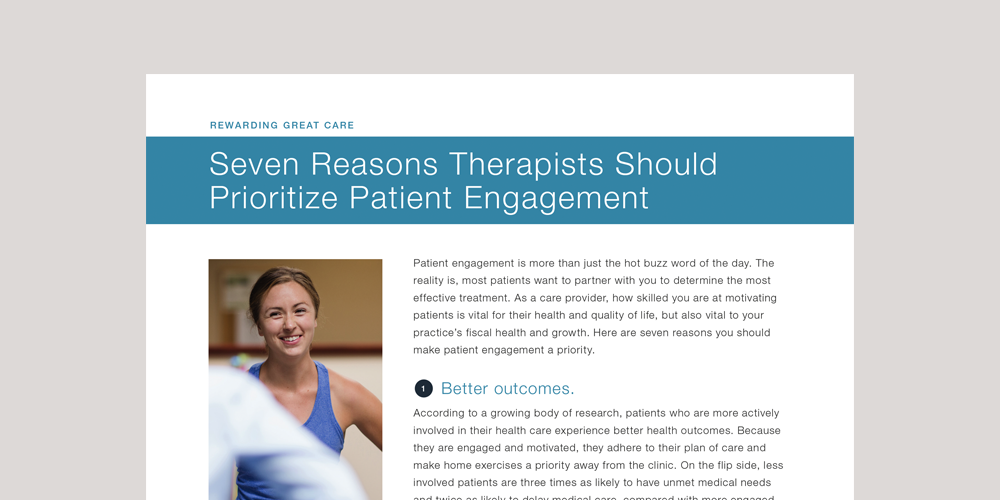Walking into my most recent doctor’s visit, I had low expectations. Like so many patients, I was afraid of being funneled in and out in 15 minutes feeling unheard and misunderstood. So I was a little surprised when as we were reviewing my symptoms, the nurse suddenly stopped me and said, “I know how you feel. I’m a patient as well and that exact same thing has happened to me.” Somewhat shocked by her openness, I asked her to tell me a little more. While the details of the story she then shared don’t matter in this context, in the moments I was sitting there with her, they did. In that instant, she helped me relax. By offering a simple story of her own, she showed me that she did in fact understand what I was saying, and I felt comfortable sharing more. In 30 seconds she empowered me to feel confident sitting there as a new patient.
There is power in story. It’s the foundation of our communication; the connective tissue of our experiences. From our earliest days, when cave walls were our chosen canvas, story has always been at the center of our lives. As people, we’re motivated by meaning and we derive that meaning from stories. A narrative creates context in a way that words alone simply can’t. And yet, story is often absent in a clinical setting.
With increased patient volumes leading to decreased time with each patient, it can be hard to take the time to be personal. But when it comes to eliciting behavior change to drive adherence, story is an invaluable tool.
3 Reasons More Stories Belong in Your Clinic
Patients want to feel like they’ve found a partner in their health.
One of the easiest ways to make complex information relevant is through stories. It’s safe to say most patients don’t have the expertise that you do, but that should never be an excuse to guard information from them. When patients are engaged in their care and they understand it, they experience better outcomes. To truly engage them and make them feel like a joint decision maker in their health though, they need to understand their care plan. Story makes it easier for people to connect the dots.
Stories help patients process and understand their injury.
As much as we’d like to think that recovery or rehabilitation is solely a physical endeavor, it’s also a mental one. Denial, increased stress, and mental fatigue are detrimental to patient success. Story has the power to empower patients in their own understanding of what is happening to them.
Patients want to feel understood.
The best way to make someone feel understood is to meaningfully engage with them. In the shuffle of 15 minute appointments, patients have to fight to feel like they exist. They want to feel like they mean something, like they’re a unique person with unique experiences. Undoubtedly they are, but communicating that is a battle in its own right. Listening to a patient’s story, not just their symptoms, helps create the context of understanding they’re seeking. When you acknowledge a patient’s story, they are less inclined to feel like they need to reiterate their concerns to you again.
3 Tips for Clinical Storytelling
Don’t be afraid to share a personal story or two.
We make sense of our daily lives through story, we find comfort in the connection to the experiences of others that it offers. Sharing your own stories makes you more human to your patients, and it helps them trust you. Employees who like their bosses typically want to work harder for them—the same could be said of the patient-provider relationship.
Think of stories for common injuries ahead of time.
The beautiful thing about stories is that they often stay relevant over time. A recent story doesn’t always hold more weight than a dated one; the most important aspect is that it’s relevant to your patient. There’s no denying that it can be difficult to come up with a relevant story on the spot, though. Taking a few minutes to think of stories or metaphors for common injuries ahead of time is a great way to increase the efficacy of your patient interactions. Think of your own patient stories or ask your colleagues about their memorable encounters with various injuries.
Learn the stories of your patients.
Storytelling involves both telling and listening. By taking up the listener role and choosing to engage with your patients stories and lives, you unlock communication barriers. If you take the time to learn something as simple as their occupation, you can then use stories and metaphors that will truly mean something to them—you suddenly have a shortcut to understanding. If you learn your patient is a mechanic, suddenly you have the frame of reference for how they understand things and can use mechanical metaphors to generate understanding.
You’re in a field where the gap of knowledge between you and your clients is substantial. This impacts not only patient outcomes, but the cost associated with each patient. Story becomes an incredibly important bridge between you and your patients to generate the mutual understanding, trust, and confidence it takes to increase compliance and lower costs.




Comments